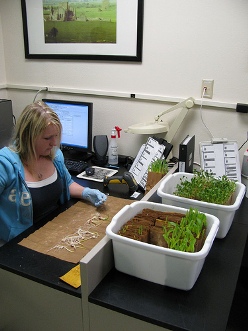Germplasm testing
.jpg) View the full chapter on seed quality testing by clicking on the icon above. (0.7 MB) |
Page compiled by: Bioversity International/ILRI, Addis Ababa, Ethiopia (Alexandra Jorge); ILRI, Addis Ababa, Ethiopia (Jean Hanson) including information extracted from: Rao NK, Hanson J, Dulloo ME, Ghosh K, Nowel D and Larinde M. 2006. Manual of seed handling in genebanks. Handbooks for Genebanks No. 8. Bioversity International, Rome, Italy. 147pp.
Proper handling procedures in genebanks are fundamental to the long-term, cost-effective and efficient conservation of plant genetic resources of the same genetic identity as the original collection. It is very important that germplasm stored in genebanks is capable of producing plants after storage when sown in the field. Genetic resources samples must have high viability at the start of storage and maintain it during storage and should have the same genetic makeup as at the time of collection to avoid loss of diversity during storage. Accessions are tested and monitored both at the start and during conservation in order to ensure the quality of the material in the genebank.
|
Testing the germination of seeds at the USDA genebank (photo: L. Guarino, by kind permission of USDA genebank in Ames, Iowa, USA) |
What is germplasm testing
The quality testing of seeds or plant material assures that the material to be conserved is in good condition, i.e. it can be grown again (viable) and is free of external contaminants (pests and diseases) and external genes (artificially produced genes). Monitoring of viability during storage allows careful observation the material and ensures that it is not lost through loss of viability or genetic integrity during conservation.
Germplasm is usually tested for
Viability and quantity are also monitored during the storage period.
Comments
- No comments found



 Germplasm testing
Germplasm testing

Leave your comments
Post comment as a guest